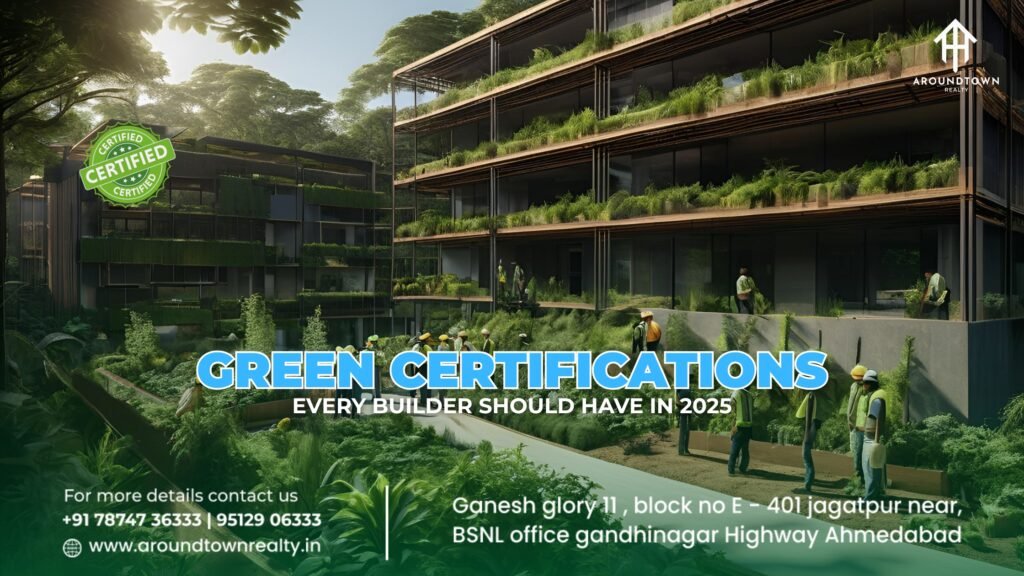Introduction: Why Green Certifications Matter in 2025
As India’s real estate market moves towards more responsible, eco-conscious development, green certifications have become more than just a badge of honor—they’re now a buyer expectation. With rapid urbanization, climate concerns, and rising utility costs, homebuyers in 2025 are looking for more than aesthetics—they want homes that offer sustainability, energy efficiency, and long-term cost savings.
Whether it’s a first-time homebuyer in Ahmedabad or a luxury investor in Mumbai, green credentials have begun influencing purchase decisions, property valuations, and even resale timelines. Builders and developers who ignore these evolving preferences risk being left behind in a rapidly competitive market.
This blog explores the top green certifications builders should have in 2025, why they matter, how they impact buyer confidence, and how to spot authentic certifications in marketing material.
1. Understanding Green Building Certifications
Green certifications are official validations that a building meets certain sustainability benchmarks. These benchmarks may include:
- Energy efficiency
- Water conservation
- Use of eco-friendly materials
- Waste management systems
- Indoor air quality
- Innovation in design
They serve two purposes:
- For the buyer: A guarantee that the home is better for the environment and cheaper to maintain.
- For the builder: A marketing tool and a way to stand out in an oversaturated market.
2. Top Green Certifications Builders Should Have in India (2025)
A. IGBC (Indian Green Building Council) Certification
What It Is:
India’s most recognized green rating system, established by CII (Confederation of Indian Industry). IGBC covers both residential and commercial projects.
Why It Matters in 2025:
- Recognized by the government and urban local bodies
- Buyers trust IGBC ratings for energy and water savings
- Comes with tiered certifications: Certified, Silver, Gold, and Platinum
Key Focus Areas:
- Rainwater harvesting
- Solar energy integration
- Natural ventilation and daylighting
- Non-toxic construction materials
Projects that benefit the most:
Gated communities, apartment complexes, integrated townships
B. GRIHA (Green Rating for Integrated Habitat Assessment)
What It Is:
Developed by TERI and endorsed by the Ministry of New and Renewable Energy, GRIHA is tailored for Indian climate and construction practices.
Why It’s Valuable in 2025:
- Emphasizes passive design strategies and indigenous materials
- Suitable for both private and public sector developments
- Increasingly used in Tier 2 and Tier 3 cities
GRIHA Focus Areas:
- Waste management
- Resource optimization during construction
- Indoor environment quality
- Community-level sustainability
Fun Fact:
Homes with GRIHA rating are now being preferred by government employees and defense housing buyers due to institutional policies.
C. EDGE Certification (IFC – World Bank)
What It Is:
EDGE stands for Excellence in Design for Greater Efficiencies. Developed by the International Finance Corporation (World Bank Group), EDGE is rapidly gaining traction in emerging markets like India.
Why It Matters in 2025:
- Provides quantified performance benchmarks (like 20% less energy, water, and embodied energy in materials)
- Fast-tracked and cost-effective compared to traditional systems
- Recognized by global investors and ESG (Environmental, Social, Governance) funders
Best Suited For:
Mid-income and affordable housing, co-living projects, institutional buildings
D. LEED Certification (Leadership in Energy and Environmental Design)
What It Is:
A globally recognized rating system developed by the U.S. Green Building Council. Though more common in commercial real estate, it’s making its way into luxury residential projects.
Why It’s Gaining Popularity in India:
- Seen as an international gold standard
- High demand among NRI and HNI buyers
- LEED-certified projects often enjoy better resale potential
LEED Key Areas:
- Energy modeling
- Carbon footprint reduction
- Efficient HVAC and lighting systems
- Eco-friendly interiors
In 2025, builders who target the global investor base or expat clients are strongly encouraged to pursue LEED certification.
E. BEE Star Rating (Bureau of Energy Efficiency)
What It Is:
Known for rating appliances, BEE also rates buildings for their energy performance.
Why It’s Important for Builders:
- Used for large apartment complexes and office buildings
- Government incentives for 4-star and 5-star rated buildings
- Energy modeling and simulation-based approach
Benefits to Buyers:
- Lower electricity bills
- Better climate responsiveness
- Stronger thermal insulation standards
3. Benefits of Green Certifications for Builders
✅ Increased Buyer Trust
Buyers today are more educated and digitally savvy. Green labels act as trust badges that signal transparency, modernity, and eco-awareness.
✅ Higher Pricing Power
Projects with green credentials can command a 5–10% premium compared to conventional properties—especially in metro markets.
✅ Faster Regulatory Approvals
Many municipal bodies offer single-window clearance or expedited permissions to certified green buildings.
✅ Attract Institutional and ESG Investors
With ESG (Environmental, Social, and Governance) funds flowing into Indian real estate, certified projects are more attractive to global financiers.
✅ Long-Term Operational Cost Savings
Energy and water-efficient buildings offer reduced running costs, which builders can use as a selling point for larger unit sizes or premium amenities.
4. What Buyers Should Watch Out For
Not all green claims are created equal. As a buyer in 2025, here’s how to spot genuine green certifications:
- Ask for documentation: Builders should be able to show IGBC or GRIHA pre-certification letters, EDGE reports, or LEED registration proof.
- Look for signages and disclosures in the project marketing material.
- Visit the site: Look for solar panels, dual plumbing lines, rainwater harvesting pits, and energy-efficient fixtures.
- Check official websites: IGBC, GRIHA, and EDGE publish lists of certified projects.
5. Trends: How Green Certifications Are Evolving in 2025
1. Micro-Certification for Specific Features
Instead of full-building certification, some builders are going for module-based ratings—e.g., IGBC for landscaping, EDGE for HVAC systems, etc.
2. Integration with Smart Home Technology
Green homes are now pairing with smart meters, solar apps, and IoT-based energy analytics, giving buyers real-time data on their carbon footprint.
3. Demand in Non-Metro Markets
Cities like Coimbatore, Nashik, Indore, and Rajkot are seeing a rise in green-certified homes, thanks to awareness and builder education.
4. Resale Premiums and Tenant Preference
Tenants, especially in IT corridors and educational hubs, prefer eco-certified rentals for their lower utility bills and better indoor air quality—making such homes a great investment.
6. Government Incentives for Green Buildings in India
Several incentives are pushing the adoption of green certifications:
- Fast-track approvals for IGBC and GRIHA projects
- Property tax rebates in cities like Pune, Ahmedabad, and Hyderabad
- Financial subsidies for solar panels and rainwater harvesting installations
- TDR (Transfer of Development Rights) benefits in some states for green infrastructure
Builders who take advantage of these schemes save on development costs and pass that value to eco-conscious buyers.
Conclusion: Certifications Are the New Status Symbol
In 2025, buyers are no longer swayed by marble floors alone. They want green, smart, efficient, and future-ready homes. For builders, having a green certification is no longer optional—it’s a strategic advantage, a compliance necessity, and a powerful marketing differentiator.
Whether you’re a buyer evaluating your next home or a builder preparing your next project launch, green certifications are the currency of trust in the new era of Indian real estate.
Want to Buy a Certified Green Home in Ahmedabad?
Around Town Realty helps you discover homes with verified IGBC, GRIHA, and EDGE certifications—so you can invest smart and live sustainably.
FAQs: Green Certifications for Builders in 2025
- Are green-certified homes more expensive?
Initially, yes—by about 5–10%. But they save money long-term through lower energy, water, and maintenance costs. - Do all builders provide green certification documents to buyers?
They should. Ask for proof of certification status and registration details before purchase. - Which is the best certification for residential buildings in India?
IGBC and GRIHA are the most common and government-supported systems. EDGE is great for affordable housing. - Can older buildings get green certifications?
Yes, through retrofitting and fulfilling performance benchmarks, existing buildings can apply for certification under specific programs. - Do green buildings have higher resale value?
Yes. Buyers and tenants increasingly prefer certified homes, leading to faster sales and better ROI.









